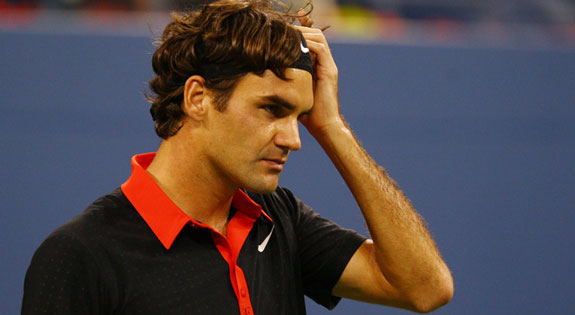
Roger Federer is returning to Davis Cup duty this weekend to help lead Switzerland to victory against Italy in the Davis Cup Play-off in Genova, Italy. It was against Italy back in 1999 when Federer – then age 17 – made his Davis Cup debut. His performance against the Italians proved to be an early indication that Federer was indeed going to become one of the sports great talents. Federer’s experience against the Italians proved to be a catapult for the young star who would crack the top 100 in the world rankings later in the year. Rene Stauffer, author of the book THE ROGER FEDERER STORY: QUEST FOR PERFECTION ($24.95, New Chapter Press, www.NewChapterMedia.com), describes Federer’s Italian Davis Cup experience and what followed shortly thereafter in 1999 in this book excerpt.
Before the outdoor season—and his series of first-round defeats—Federer achieved another career highlight in April—his Davis Cup debut. Switzerland was slated to play against Italy in a first-round match in Neuenburg, Switzerland. However, the Swiss team experienced some tumultuous months leading into the tie as Marc Rosset, the No. 1 Swiss player, quarreled and separated from his coach of 11 years, Stephane Oberer, and threatened to quit the Davis Cup if Oberer remained the captain of the Swiss team. Luckily, Oberer resigned at the beginning of February and was replaced shortly thereafter by Claudio Mezzadri, a former top-30 ranked Swiss player.
Federer’s Davis Cup debut could not have been better. He decisively beat Italian No. 1 Davide Sanguinetti, ranked No. 48 in the world, 6-4, 6-7 (3), 6-3, 6-4 in his first match in the 3-2 win for the Swiss. “It was unfortunate that Federer was playing for the opponent,” Italy’s team captain, Paolo Bertolucci, said afterwards, “but it was fun to watch him. There are not many people in the world who can play tennis so well.”
In July, the Swiss played Belgium in Brussels in the quarterfinals and Federer, not quite 18-years-old, found himself acting as the leader of the Swiss team in only his second match as a member of the team. The higher-ranked Rosset was with the team in Brussels, but was feeling ill during the week and, after much deliberation, declined to play singles in the tie. Federer was unable to carry the Swiss team on his back as he lost two marathon matches to Christophe van Garsse and Xavier Malisse in the Swiss loss.
At the time, Federer was an inconsistent player with the fascinating repertoire of strokes. He still had trouble concentrating and often couldn’t find his way to winning matches, despite his technical superiority. This was especially the case in matches that exceeded three sets, where stamina, patience and tactical maturity—not brilliance—were required. He became irritated when the wind and weather altered playing conditions and when fans moved in the grandstands.
However, he consistently proved that he had everything it took to compete with the pros—indoors or outdoors—regardless of court surfaces. This proved to be the case on the clay courts at Roland Garros, where the 17-year-old made his main draw Grand Slam tournament debut as the youngest competitor in the men’s field. In his first-round match, Federer drew Patrick Rafter, the Australian two-time US Open champion. He jumped out to win the first set against the world’s No. 3-ranked player who then was at the peak of his career. However, the sun came out and the conditions became warmer and faster. The clay courts dried out and balls moved much faster through the court. The Australian’s attacking serve-and-volley style seemed to run on automatic and he won in four sets.
“The young man from Switzerland could be one of the people who will shape the next ten years,” the French sports newspaper L’Equipe wrote during the tournament. Rafter shared the same opinion. “The boy impressed me very much,” he said. “If he works hard and has a good attitude, he could become an excellent player.” Asked at a press conference what he was still lacking to beat such players, Federer said, “I just have to mature.”
Four weeks later, Federer made his main draw debut at Wimbledon and faced the experienced Czech, Jiri Novak. It was only Federer’s second appearance in the main draw of a Grand Slam tournament, but he once again showed that he could dominate a match over long stretches. It appeared he was on his way to a victory—leading Novak two sets to one—when his concentration began to fade and he became mired down in the first five-set match of his career. Federer’s inexperience showed as he was unable to capitalize on eight break points in the deciding set—and lost.
After the string of seven first-round defeats in Key Biscayne, Monte Carlo, Paris, Queens, Wimbledon, Gstaad and Washington, D.C.—as well as the Davis Cup disappointment in Brussels—Federer lost in the qualifying rounds at ATP events in Long Island and the US Open in New York. Federer’s crisis, however, suddenly vanished when the indoor season began in the fall of 1999.
With a first-round win over former Wimbledon and US Open finalist Cedric Pioline of France in Tashkent, Uzbekistan, Federer reached the top 100 in the world rankings, and at the age of 18, he was the youngest player within the group. He beat another seven opponents on the ATP Tour by the end of the year and reached his first career ATP semifinal in Vienna. He ended the year by winning the challenger tournament in Brest, France in his last tournament appearance in a challenger or satellite-level event. From this point forward, Federer only competed on the ATP Tour and in the Grand Slam events. It took him only about a year to transition from an inexperienced newcomer into an established professional.
